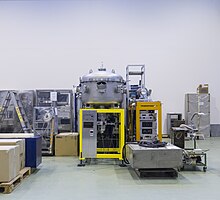| List of ISOLDE experimental setups | |
|---|---|
| COLLAPS, CRIS, EC-SLI, IDS, ISS, ISOLTRAP, LUCRECIA, Miniball, MIRACLS, SEC, VITO, WISArD | |
| Other facilities | |
| MEDICIS | Medical Isotopes Collected from ISOLDE |
| 508 | Solid State Physics Laboratory |

The Scattering Experiments Chamber (SEC) experiment is a permanent experimental setup located in the ISOLDE facility at CERN. The station facilitates diversified reaction experiments, especially for studying low-lying resonances in light atomic nuclei via transfer reactions. SEC does not detect gamma radiation, and therefore is complementary to the ISOLDE Solenoidal Spectrometer (ISS) and Miniball experiments.
Experimental setup
The SEC experiment uses radioactive ion beams from ISOLDE, at the end of XT03 beamline of the HIE-ISOLDE facility. The ion beam first passes through a collimator, of 15 mm aperture, surrounded by 4 silicon detectors, designed for beam optimisation.
The SEC chamber has a diameter of 1 m and height of 50 cm, with the reaction target placed in the centre on a motorised target holder. The target holder has the space for four targets, and each target can be moved in place via remote control. The reaction target is surrounded by double-sided silicon strip detectors (DSSSD) which are positioned so that the angular coverage is optimised, depending on the experiment. DSSSDs allow for efficient detection of all emitted particles in the reaction. The main support for the detector is a circular movable table which has radially arranged holes at the centre.

GLORIA
GLORIA (GLObal ReactIon Array) is a configuration used in SEC to measure fragments produced in reactions. It consists of six silicon telescopes, which surround a certain scattering angle of the reaction target (from 15° to 160°. GLORIA was designed to have a compact geometry with the ability to resolve mass and ion charge up to carbon isotopes, due to the two-stage DSSD telescopes.
SAND
The SAND array is used at the scattering chamber SEC, for the detection of charged particles and neutrons. The array consists of 30 modules, each being a plastic scintillator with fast photomultiplier tubes. The array can be moved to bring it closer to the target.
External links
References
- "SEC | ISOLDE". isolde.cern. Retrieved 2023-08-03.
- Martel, I; Tengblad, O; Cederkall, J (29 Apr 2019). "Physics at ISOLDE with SEC" (PDF). indico.cern. Retrieved 3 Aug 2023.
- Sparta, Roberta; Figuera, P.; Pietro, A. di; Tengblad, Olof; Fernández-García, J. P.; Acosta-Sánchez, Luis Armando; Bjorn, Jonson; García Borge, María José; Bruni, Giovanni; Davison, Thomas; Ovejas, J. D.; Fraile, Luis M.; Galaviz, D.; Halkjaer Jensen, Jesper; La Cognata, Marco (2019-12-05). "Elastic scattering of p-halo 8B beam close to the Coulomb barrier". Comunicaciones Congresos.
- ^ "S E C : Scattering Experiments Chamber at XT03 HIE-ISOLDE". isolde-sec.web.cern.ch. Retrieved 2023-08-14.
- Kundalia, K.; Gupta, D.; Ali, Sk M.; Saha, Swapan K.; Tengblad, O.; Ovejas, J. D.; Perea, A.; Martel, I.; Cederkall, J.; Park, J.; Szwec, S.; Moro, A. M. (2022-10-10). "Study of elastic and inelastic scattering of 7Be + 12C at 35 MeV". Physics Letters B. 833: 137294. arXiv:2207.10865. doi:10.1016/j.physletb.2022.137294. ISSN 0370-2693.
- Fynbo, H. O. U.; Diget, C. Aa.; Prezado, Y.; Äystö, J.; Bergmann, U. C.; Cederkäll, J.; Dendooven, P.; Fraile, L. M.; Franchoo, S.; Fulton, B. R.; Huang, W.; Huikari, J.; Jeppesen, H.; Jokinen, A.; Jonson, B. (2004-06-28). "News on 12C from β-decay studies". Nuclear Physics A. Proceedings of the 8th International Conference on Clustering Aspects of Nuclear Structure and Dynamics. 738: 59–65. doi:10.1016/j.nuclphysa.2004.04.012. ISSN 0375-9474.
- Ovejas, J.D.; Knyazev, A.; Martel, I.; Tengblad, O.; Borge, M.J.G.; Cederkäll, J.; Keeley, N.; Rusek, K.; García-Ramos, C.; Acosta, L.A.; Arokiaraj, A.A.; Babo, M.; Cap, T.; Ceylan, N.; de Angelis, G. (2020). "Halo Effects in the Low-energy Scattering of \(^{15}\)C with Heavy Targets". Acta Physica Polonica B. 51 (3): 731. doi:10.5506/APhysPolB.51.731. hdl:10272/18868. ISSN 0587-4254.
- ^ Marquínez-Durán, G.; Acosta, L.; Berjillos, R.; Dueñas, J. A.; Labrador, J. A.; Rusek, K.; Sánchez-Benítez, A. M.; Martel, I. (2014-08-11). "GLORIA: A compact detector system for studying heavy ion reactions using radioactive beams". Nuclear Instruments and Methods in Physics Research Section A: Accelerators, Spectrometers, Detectors and Associated Equipment. 755: 69–77. Bibcode:2014NIMPA.755...69M. doi:10.1016/j.nima.2014.04.002. hdl:10261/288100. ISSN 0168-9002.
- Gupta, D; Kundalia, K; Ali, Sk M; Maity, S; Mitra, R; Saha, Swapan K; Tengblad, O; Tavora, V G; Perea, A; Borge, M J G; Martel, I; Cederkall, J; Chishti, M; Park, J; Moro, A M (26 Sep 2022). "Breakup of 9Li to study the 8Li(n,γ) reaction" (PDF). Proposal to the ISOLDE and Neutron Time-of-Flight Committee.
- Borge, M J G; Briz, J A; Cederkall, J; De Angelis, G; Figuera, P P; Fraile, L M; Fynbo, H O U; Gad, A; Heinz, A; Holl, M; Jensen, E; Johansen, J G; Johansson, H T; Jonson, B; et al. (6 Jan 2021). "Reaction studies with neutron-rich light nuclei at the upgraded SEC Device" (PDF). Proposal to the ISOLDE and Neutron Time-of-Flight Committee.